Sustainability Evaluation on the Grain to Green Program in the Hexi Corridor of China: A Metacoupled System Perspective
Abstract
:1. Introduction
2. Materials and Methods
2.1. Study Area
2.2. Telecoupling Geo App
2.3. InVEST Model and Climate Data
2.4. Understanding the Metacoupled System
3. Results
3.1. Flows in the Metacoupled System
3.2. Causes in the Metacoupled System
3.3. Effects in the Metacoupled System
4. Discussion
5. Conclusions
Author Contributions
Funding
Institutional Review Board Statement
Informed Consent Statement
Data Availability Statement
Acknowledgments
Conflicts of Interest
References
- Yang, H.; Yang, W.; Zhang, J.; Connor, T.; Liu, J. Revealing pathways from payments for ecosystem services to socioeconomic outcomes. Sci. Adv. 2018, 4, 1–8. [Google Scholar] [CrossRef] [Green Version]
- Wunder, S.; Engel, S.; Pagiola, S. Taking stock: A comparative analysis of payments for environmental services programs in developed and developing countries. Ecol. Econ. 2008, 65, 834–852. [Google Scholar] [CrossRef]
- Engel, S.; Pagiola, S.; Wunder, S. Designing payments for environmental services in theory and practice: An overview of the issues. Ecol. Econ. 2008, 65, 663–674. [Google Scholar] [CrossRef]
- Naeem, S.; Ingram, J.C.; Varga, A.; Agardy, T.; Barten, P.; Bennett, G.; Bloomgarden, E.; Bremer, L.L.; Burkill, P.; Cattau, M.; et al. Environment and Development. Get the science right when paying for nature’s services. Science 2015, 347, 1206–1207. [Google Scholar] [CrossRef] [Green Version]
- Sommerville, M.M.; Jones, J.P.G.; Milner-Gulland, E.J. A revised conceptual framework for payments for environmental services. Ecol. Soc. 2009, 14. [Google Scholar] [CrossRef] [Green Version]
- Liu, J.; Li, S.; Ouyang, Z.; Tam, C.; Chen, X. Ecological and socioeconomic effects of China’s policies for ecosystem services. Proc. Natl. Acad. Sci. USA 2008, 105, 9477–9482. [Google Scholar] [CrossRef] [Green Version]
- Fang, B.; Tan, Y.; Li, C.; Cao, Y.; Liu, J.; Schweizer, P.J.; Shi, H.; Zhou, B.; Chen, H.; Hu, Z. Energy sustainability under the framework of telecoupling. Energy 2016, 106, 253–259. [Google Scholar] [CrossRef] [Green Version]
- Liu, C.; Lü, J.; Yin, R. An estimation of the effects of China’s forestry programs on farmers’ income. An Integr. Assess. China’s Ecol. Restor. Programs 2009, 201–218. [Google Scholar] [CrossRef]
- Kates, R.W.; Clark, W.C.; Corell, R.; Hall, J.M.; Jaeger, C.C.; Lowe, I.; McCarthy, J.J.; Schellnhuber, H.J.; Bolin, B.; Dickson, N.M.; et al. Environment and development: Sustainability science. Science 2001, 292, 641–642. [Google Scholar] [CrossRef]
- Ferraro, P.J.; Hanauer, M.M. Quantifying causal mechanisms to determine how protected areas affect poverty through changes in ecosystem services and infrastructure. Proc. Natl. Acad. Sci. USA 2014, 111, 4332–4337. [Google Scholar] [CrossRef] [Green Version]
- Law, E.A.; Ferraro, P.J.; Arcese, P.; Bryan, B.A.; Davis, K.; Gordon, A.; Holden, M.H.; Iacona, G.; Marcos Martinez, R.; McAlpine, C.A.; et al. Projecting the performance of conservation interventions. Biol. Conserv. 2017, 215, 142–151. [Google Scholar] [CrossRef] [Green Version]
- Kotchen, M.J.; Young, O.R. Meeting the challenges of the anthropocene: Towards a science of coupled human-biophysical systems. Glob. Environ. Change 2007, 17, 149–151. [Google Scholar] [CrossRef]
- Schlüter, M.; McAllister, R.R.J.; Arlinghaus, R.; Bunnefeld, N.; Eisenack, K.; Hölker, F.; Milner-Gulland, E.J.; Müller, B.; Nicholson, E.; Quaas, M.; et al. New horizons for managing the environment: A review of coupled social-ecological systems modeling. Nat. Resour. Model. 2012, 25, 219–272. [Google Scholar] [CrossRef]
- Liu, J.; Dietz, T.; Carpenter, S.R.; Alberti, M.; Folke, C.; Moran, E.; Pell, A.N.; Deadman, P.; Kratz, T.; Lubchenco, J.; et al. Complexity of Coupled Human and Natural Systems. Science 2007, 317, 1513–1516. [Google Scholar] [CrossRef] [Green Version]
- Liu, J.; Hull, V.; Batistella, M.; Defries, R.; Dietz, T.; Fu, F.; Hertel, T.W.; Izaurralde, R.C.; Lambin, E.F.; Li, S.; et al. Framing Sustainability in a Telecoupled World. Ecol. Soc. 2013, 18, 26. [Google Scholar] [CrossRef]
- da Silva, R.; Batistella, M.; Dou, Y.; Moran, E.; Torres, S.; Liu, J. The Sino-Brazilian Telecoupled Soybean System and Cascading Effects for the Exporting Country. Land 2017, 6, 53. [Google Scholar] [CrossRef] [Green Version]
- Liu, J.; Hull, V.; Moran, E.; Nagendra, H.; Swaffield, S.R.; Turner II, B.L. Applications of the Telecoupling Framework to Land-Change Science. Rethink. Glob. Land Use Urban Era 2014, 14, 119–140. [Google Scholar] [CrossRef]
- Sun, J.; TONG, Y.X.; Liu, J. Telecoupled land-use changes in distant countries. J. Integr. Agric. 2017, 16, 368–376. [Google Scholar] [CrossRef]
- Liu, J. Forest Sustainability in China and Implications for a Telecoupled World. Asia Pac. Policy Stud. 2014, 1, 230–250. [Google Scholar] [CrossRef] [Green Version]
- Deines, J.M.; Liu, X.; Liu, J. Telecoupling in urban water systems: An examination of Beijing’s imported water supply. Water Int. 2016, 41, 251–270. [Google Scholar] [CrossRef]
- Liu, J.; Yang, W.W. Integrated assessments of payments for ecosystem services programs. Proc. Natl. Acad. Sci. USA 2013, 110, 16297–16298. [Google Scholar] [CrossRef] [Green Version]
- Liu, J.; Yang, W.; Li, S. Framing ecosystem services in the telecoupled Anthropocene. Front. Ecol. Environ. 2016, 14, 27–36. [Google Scholar] [CrossRef]
- Li, J.; Feldman, M.W.; Li, S.; Daily, G.C. Rural household income and inequality under the Sloping Land Conversion Program in western China. Proc. Natl. Acad. Sci. USA 2011, 108, 7721–7726. [Google Scholar] [CrossRef] [Green Version]
- Cao, S.; Wang, X.; Song, Y.; Chen, L.; Feng, Q. Impacts of the Natural Forest Conservation Program on the livelihoods of residents of Northwestern China: Perceptions of residents affected by the program. Ecol. Econ. 2010, 69, 1454–1462. [Google Scholar] [CrossRef]
- Liu, J.; Diamond, J. Revolutionizing China’s Environmental Protection. Science 2008, 319, 37–38. [Google Scholar] [CrossRef]
- Uchida, E.; Xu, J.; Rozelle, S. Grain for Green: Cost-Effectiveness and Sustainability of China’s Conservation Set-Aside Program. Land Econ. 2005, 81, 247–264. [Google Scholar] [CrossRef]
- Zhang, H.; Peng, D.; Deng, R.; Wang, D.; Han, Y. Dynamic Change of Land Use in Qilian Mountains Based on Time-series Landsat Image. Beijing Gongye Daxue Xuebao/Journal Beijing Univ. Technol. 2017, 43, 665–676. [Google Scholar] [CrossRef]
- Wu, Z.L.; Jia, W.X.; Zhao, Z.; Zhang, Y.S.; Liu, Y.R.; Chen, J.H. Spatial-temporal variations of vegetation and its correlation with climatic factors in Qilian Mountains from 2000 to 2012. Arid L. Geogr. 2015, 38. [Google Scholar] [CrossRef]
- Tonini, F.; Liu, J. Telecoupling toolbox: Spatially explicit tools for studying telecoupled human and natural systems. Ecol. Soc. 2017, 22. [Google Scholar] [CrossRef]
- Guerry, A.D.; Polasky, S.; Lubchenco, J.; Chaplin-Kramer, R.; Daily, G.C.; Griffin, R.; Ruckelshaus, M.; Bateman, I.J.; Duraiappah, A.; Elmqvist, T.; et al. Natural capital and ecosystem services informing decisions: From promise to practice. Proc. Natl. Acad. Sci. USA 2015, 112, 7348–7355. [Google Scholar] [CrossRef] [Green Version]
- Liu, J. Integration across a metacoupled planet. Ecol. Soc. 2017, 22, 1–37. [Google Scholar] [CrossRef]
- Qiu, G.Y.; Yin, J.; Tian, F.; Geng, S. Effects of the “Conversion of Cropland to Forest and Grassland Program” on the Water Budget of the Jinghe River Catchment in China. J. Environ. Qual. 2011, 40, 1745. [Google Scholar] [CrossRef]
- Turner, B.L.; Kasperson, R.E.; Matson, P.A.; McCarthy, J.J.; Corell, R.W.; Christensen, L.; Eckley, N.; Kasperson, J.X.; Luers, A.; Martello, M.L.; et al. A framework for vulnerability analysis in sustainability science. Proc. Natl. Acad. Sci. USA 2003, 100, 8074–8079. [Google Scholar] [CrossRef] [PubMed] [Green Version]
- Folke, C.; Jansson, Å.; Rockström, J.; Olsson, P.; Carpenter, S.R.; Stuart Chapin, F.; Crépin, A.S.; Daily, G.; Danell, K.; Ebbesson, J.; et al. Reconnecting to the biosphere. Ambio 2011, 40, 719–738. [Google Scholar] [CrossRef] [Green Version]
- Liu, J.; Hull, V.; Luo, J.; Yang, W.; Liu, W.; Viña, A.; Vogt, C.; Xu, Z.; Yang, H.; Zhang, J.; et al. Multiple telecouplings and their complex interrelationships. Ecol. Soc. 2015, 20. [Google Scholar] [CrossRef] [Green Version]
- Yao, S.; Guo, Y.; Huo, X. An empirical analysis of the effects of China’s land conversion program on farmers’ income growth and labor transfer. Environ. Manage 2009, 159–173. [Google Scholar] [CrossRef]
- Yao, S.; Li, H.; Liu, G. Agricultural productivity changes induced by the sloping land conversion program: An analysis of wuqi county in the loess plateau region. Environ. Manage 2009, 219–233. [Google Scholar] [CrossRef]
- Lin, Y.; Yao, S. Impact of the Sloping Land Conversion Program on rural household income: An integrated estimation. Land Use Policy 2014, 40, 56–63. [Google Scholar] [CrossRef]
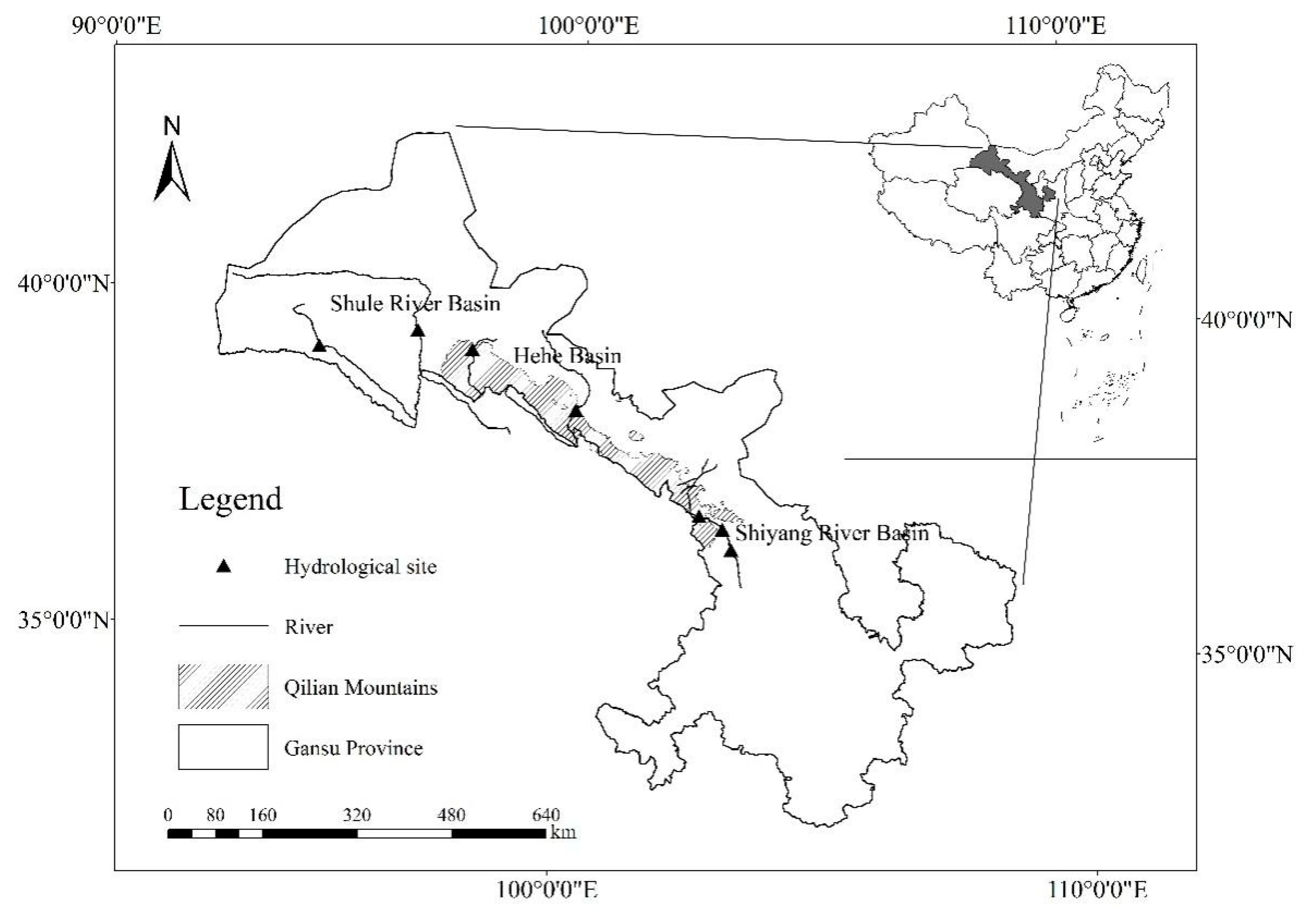
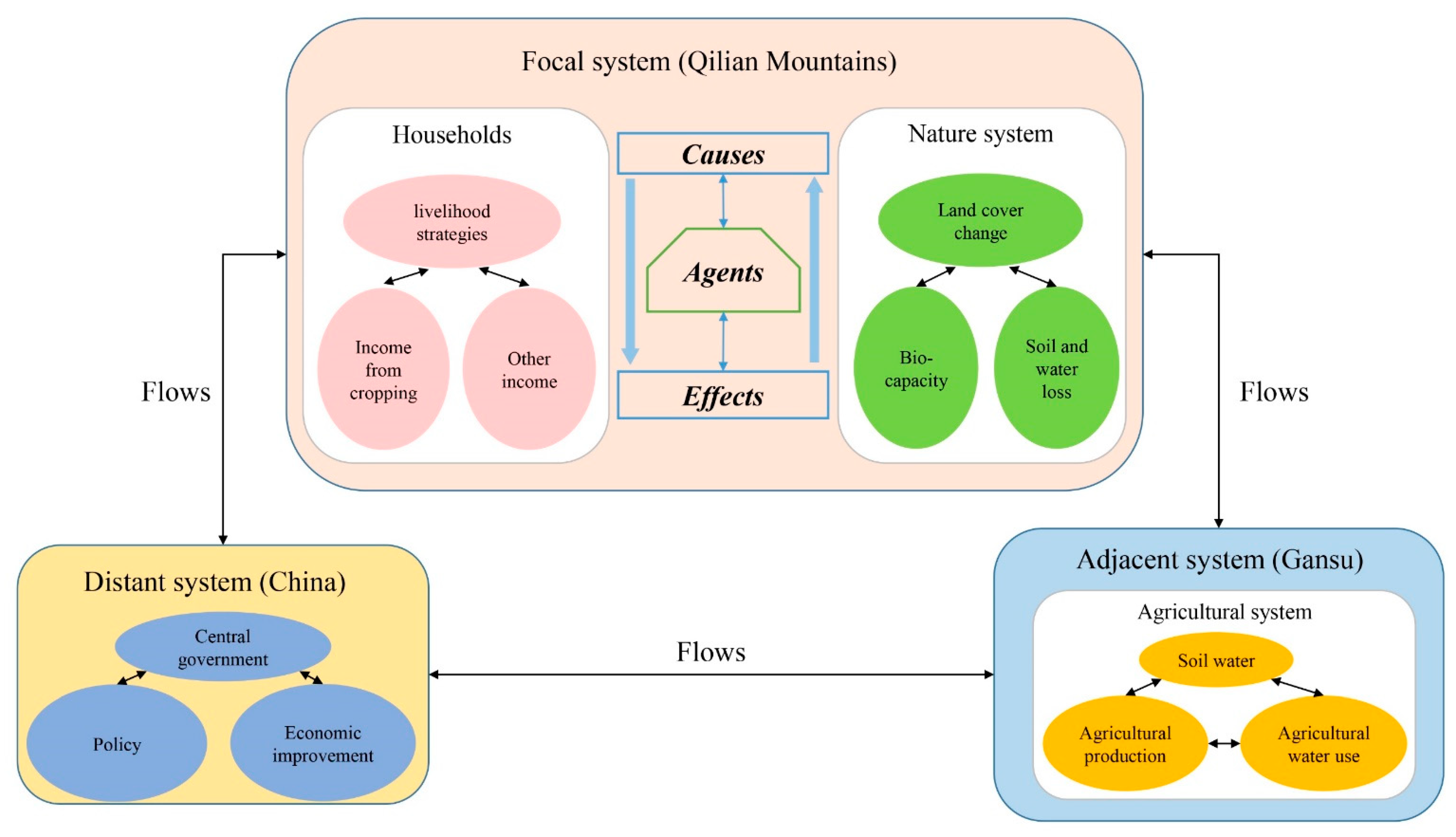
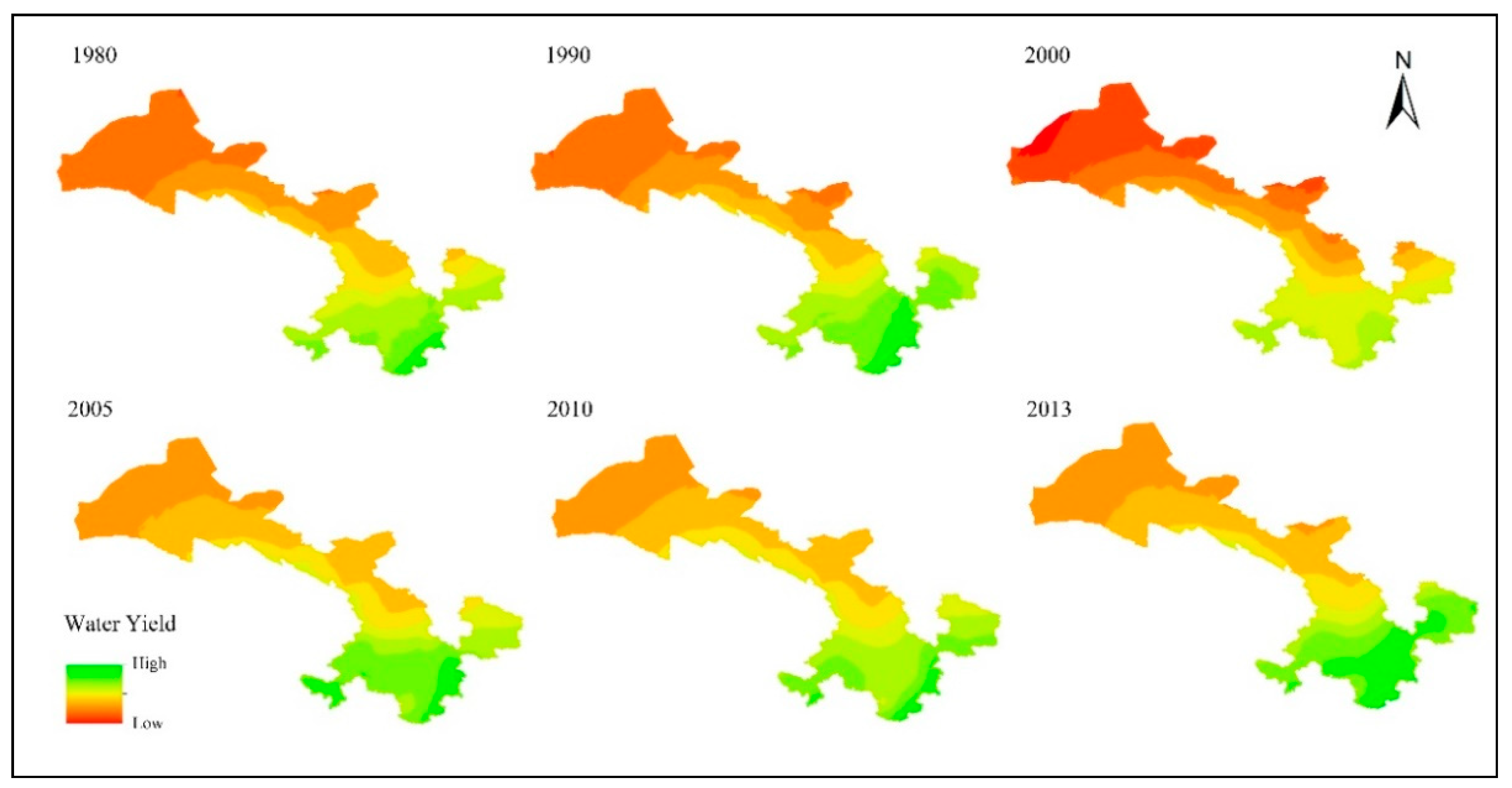
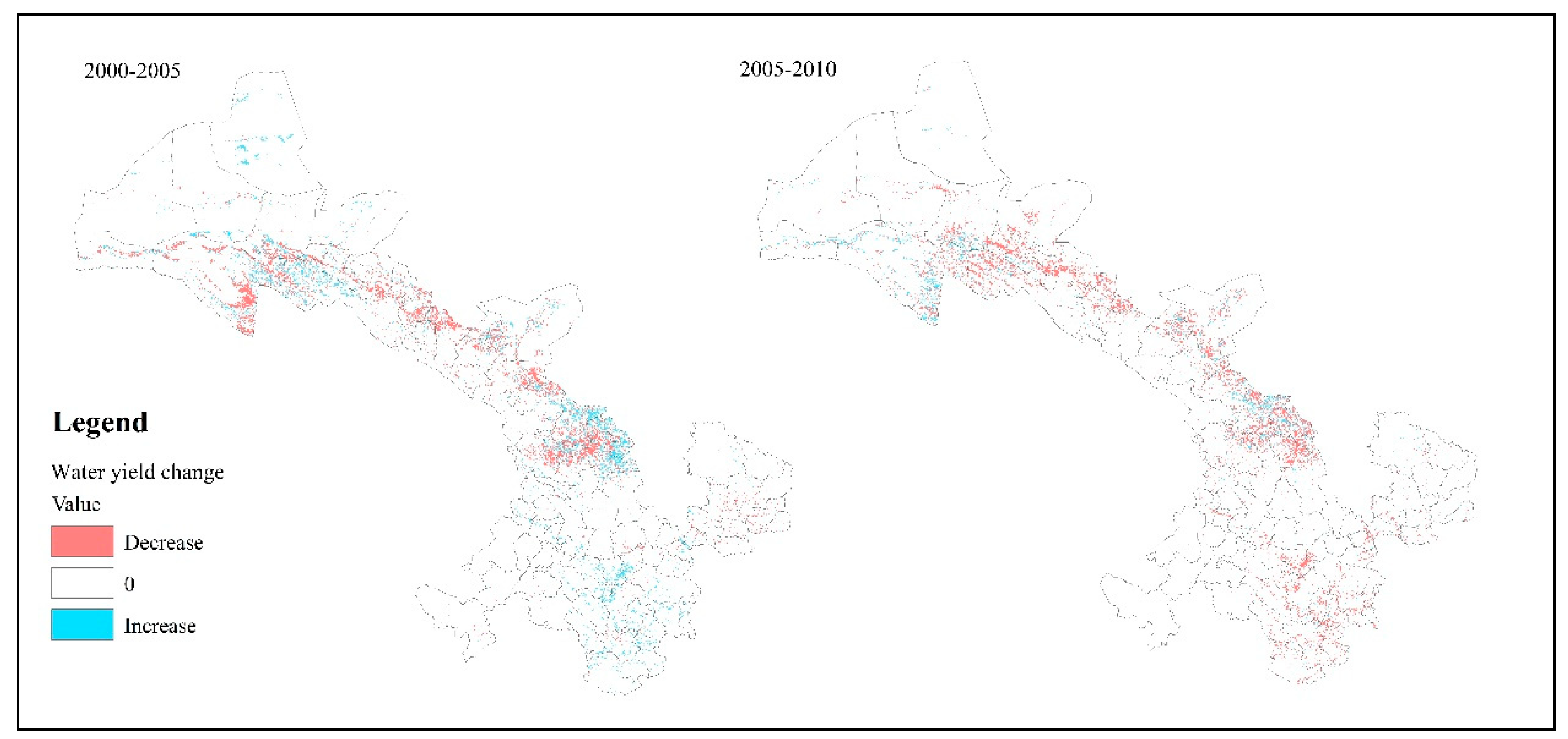
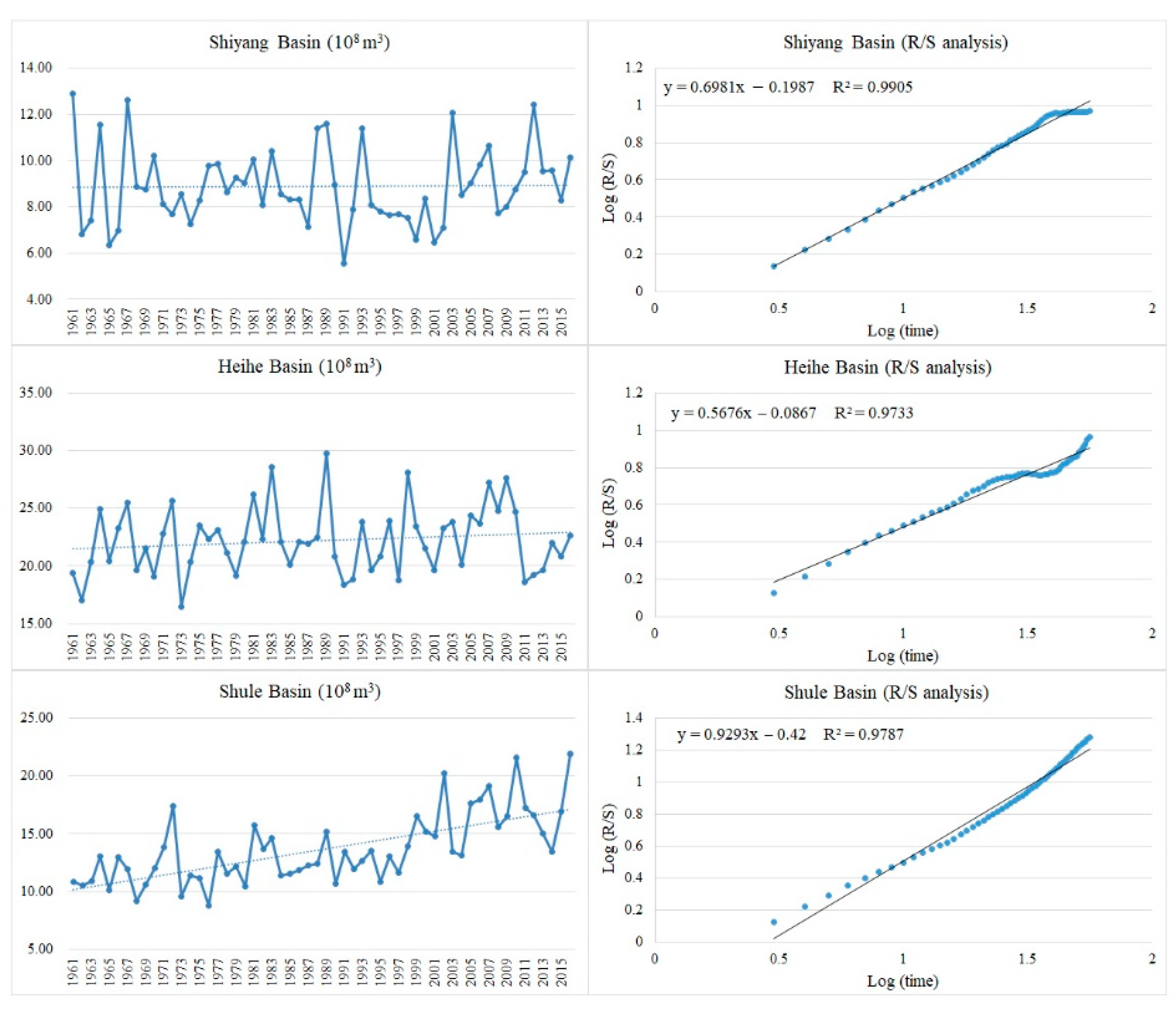
| Coding | Data |
|---|---|
| Pi,m | The annual and monthly precipitation, respectively (mm). The data is from the Chinese National Meteorological Information Center (http://data.cma.cn/). The year data is summarized and analyzed according to the data of each month of 12 months, and the difference calculation is performed every year. 12 months of raster data. |
| ET0,m | The evapotranspiration data is derived from the CGIAR CSI dataset based on World Clim data (http://www.cgiar-csi.org/data/global-aridity-and-pet-database), based on a year of 12 months. |
| DEM | The data is from the Resource and Environment Data Cloud Platform of China (http://www.resdc.cn/), and the spatial resolution is 1 km. |
| LULC | The key component for the water model is a spatially continuous land-use/land-class raster grid. That is, within a watershed, all land-use/land-class categories should be defined. The land-use data is from the University of Maryland’s Global Land Cover Facility (http://glcf.umd.edu/data/landcover/). This spatial resolution of the data is 1 km. The simplest categorization of LULCs on the landscape involves delineation by land cover only (e.g., cropland, temperate conifer forest, and prairie). Several global and regional land cover classifications are available, and often detailed land cover classification has been done for the landscape of interest. In our study, data analysis was performed based on the most basic classification. |
| Soil group | The soil group is determined by hydraulic conductivity and soil depth. Future Water created a global hydraulic map (http://www.futurewater.eu/2015/07/soil-hydraulic-properties/). |
| Land Use Type | 2000 | 2005 | 2010 | Changes from 2000 to 2010 |
|---|---|---|---|---|
| Water | 109.91 | 106.64 | 108.71 | −1.2 |
| Forest | 26,436.84 | 30,837.26 | 31,543.28 | 5106.44 |
| Shrub lands | 10,083.01 | 11,117.72 | 10,891.49 | 808.48 |
| Grassland | 181,821.8 | 182,825.9 | 183,369.2 | 1547.35 |
| Wetlands | 23,981.46 | 32,531.4 | 34,485.01 | 10,503.55 |
| Croplands | 1738.90 | 17,38.93 | 1738.61 | −0.29 |
| Urban and built-up lands | 2555.03 | 5463.8 | 6080.29 | 3525.26x |
| Non-vegetated lands | 179,073 | 161,178.3 | 157,583.4 | −21,489.58 |
Publisher’s Note: MDPI stays neutral with regard to jurisdictional claims in published maps and institutional affiliations. |
© 2021 by the authors. Licensee MDPI, Basel, Switzerland. This article is an open access article distributed under the terms and conditions of the Creative Commons Attribution (CC BY) license (http://creativecommons.org/licenses/by/4.0/).
Share and Cite
Zhang, J.; Tian, T.; Cui, J.; M. Hickey, G.; Zhou, R.; Liu, J.; Xiong, Y. Sustainability Evaluation on the Grain to Green Program in the Hexi Corridor of China: A Metacoupled System Perspective. Sustainability 2021, 13, 1498. https://doi.org/10.3390/su13031498
Zhang J, Tian T, Cui J, M. Hickey G, Zhou R, Liu J, Xiong Y. Sustainability Evaluation on the Grain to Green Program in the Hexi Corridor of China: A Metacoupled System Perspective. Sustainability. 2021; 13(3):1498. https://doi.org/10.3390/su13031498
Chicago/Turabian StyleZhang, Jian, Tao Tian, Jinying Cui, Gordon M. Hickey, Rui Zhou, Jianguo Liu, and Youcai Xiong. 2021. "Sustainability Evaluation on the Grain to Green Program in the Hexi Corridor of China: A Metacoupled System Perspective" Sustainability 13, no. 3: 1498. https://doi.org/10.3390/su13031498
APA StyleZhang, J., Tian, T., Cui, J., M. Hickey, G., Zhou, R., Liu, J., & Xiong, Y. (2021). Sustainability Evaluation on the Grain to Green Program in the Hexi Corridor of China: A Metacoupled System Perspective. Sustainability, 13(3), 1498. https://doi.org/10.3390/su13031498








